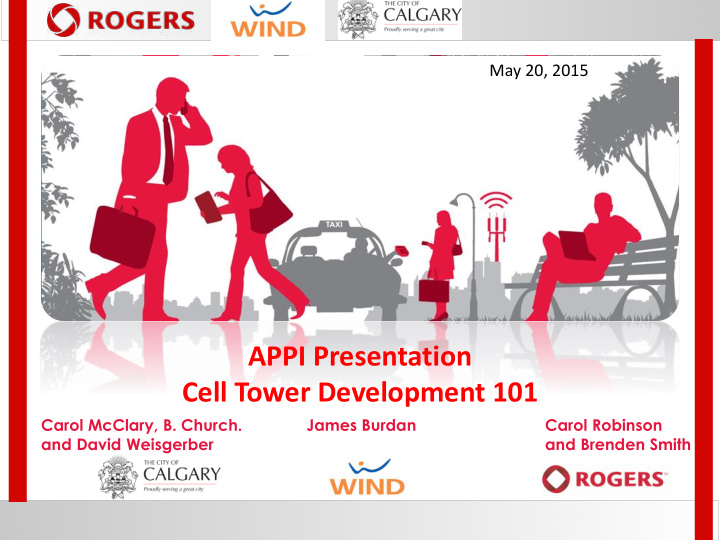



May 20, 2015 APPI Presentation Cell Tower Development 101 Carol McClary, B. Church. James Burdan Carol Robinson and David Weisgerber and Brenden Smith
Agenda Wireless Facts & Trends Regulations & Processes Public Sensitivities & Myths Examples of Development Questions & Close
Wireless Facts & Trends • 1985 – 6000 Subscribers • 2005 – 12,500,000 Subscribers • 2015 – 22,000,000 Subscribers • More than 50% of 911 calls are made from a cell phone – more like 75% • Significant Economic Impact: 37 billion invested in Communication Infrastructure between 1985 and 2013 and 5.7 billion annually in auction fees • Data Transmission increasing ±5% per month • Alberta Flood impact on network operations Sources: CWTA, March 2015, B. Church, and local knowledge. Additional Info: Alberta First Responder Radio Communications System (AFRRCS) http://www.solgps.alberta.ca/afrrcs/Pages/default.aspx
Wireless Facts & Trends A single laptop can generate as much traffic as 488 basic-feature phones. A smartphone creates as much traffic as 35 basic- featured phones.
Wireless Facts & Trends Number of calls in a cell is limited. At capacity, it reduces the coverage footprint in order to provide service to the closest users
Wireless Facts & Trends • Amber Alert • Monitoring vital signs (paramedics, seniors, etc.) • Locator/GPS • Oil/Gas Well monitoring • Smart Farming • Smart Home Monitoring • GPS/locator – Emergency Services • Drone Technology
Regulations & Processes Industry Canada – CPC-2-0-03 Letter of Concurrence/Non-Concurrence Impasse – Industry Canada Land Use Authority – Role Zoning/Setbacks Development Permit vs Letter of Concurrence Health & Safety/NavCanada/Transport Canada
Regulations & Processes • Search Area (technical analysis) • Colocation • Initial Field Scouting (search area) • Site Selection (Site Candidate Info. Package) • Municipal Pre-Consultation Involvement by Colour • Qualifications Carriers • Lease Acquisition Land Use Authority • Public Consultation Industry Canada • Letter of Concurrence Public • Industry Canada Review Challenges?
Regulations & Processes – Radiofrequency Coverage Sample coverage maps Before After
Lattice Tower Farm
Tuscany Monopole – TUC
Tuscany Monopole – TUC
Richmond Monopole
Chelsea Tri-pole Rebuild
College Tri-pole
Parking Lot Light Replacement
Streetlight Replacement
Included with Sign Monopole
Disguised in Entranceway Feature
Public Sensitivities & Myths • Current coverage vs. capacity • Aviation Concerns What’s considered a valid concern, according • Neighbor disputes to Industry Canada? • Safety Concerns • Environmental Issues and Concerns • Property Values • Ability to balance Customer demand/complaints with resident concerns and NIMBY • Health
Health Canada’s Safety Code 6 For more information: • Safety Code 6: Health Canada’s Radiofrequency Exposure Guidelines - http://www.hc- sc.gc.ca/ewh-semt/pubs/radiation/radio_guide-lignes_direct/index-eng.php • Fact Sheet – What is Safety Code 6? - http://www.hc-sc.gc.ca/ahc-asc/media/ftr-ati/_2014/2014- 023fs-eng.php
Closing & Questions • City of Calgary’s protocol • CPC-2-0-03 – Antenna Tower Siting Procedures (Industry Canada) • Guide to Assist Land-use Authorities in Developing Antenna System Siting Protocols (Industry Canada) • Health Canada FAQs
Recommend
More recommend